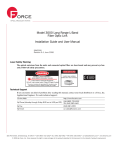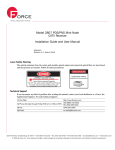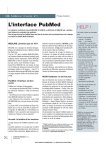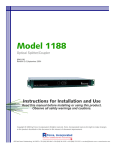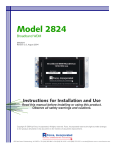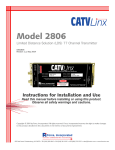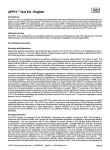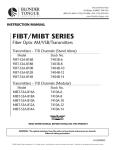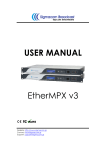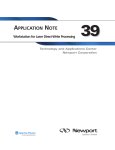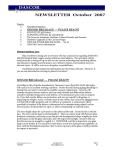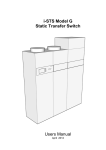Download Model 2802: Professional Singlemode 10 Channel CATV Fiber
Transcript
Model 2802: Professional Singlemode 10 Channel CATV Fiber Optic Link Installation Guide and User Manual IOM2802PRO Revision 1.0, May 2006 Laser Safety Warning The optical emissions from the units are laser-based and may present eye hazards. Follow all safety precautions Technical Support If you encounter any kind of problem after reading this manual, contact your local distributor or a Force, Inc. Applications Engineer. To reach technical support: On the Web: By Phone (Monday through Friday 8:00 am to 5:00 pm EST): By Fax: By Email: http://www.forceinc.com USA (800) 732-5252 TEL (540) 382-0462 (540) 381-0392 [email protected] 825 Park Street, Christiansburg, VA 24073 • USA (800) 732-5252• TEL (540) 382-0462 • FAX (540) 381-0392 • [email protected] • www.forceinc.com © 2006 by Force, Inc. Force reserves the right to make changes to the product described in this document in the interest of product improvement. Model 2802PRO 10 Ch. CATV Singlemode Fiber Optic Link Contents User Manual Active Product Under Warranty 14 Obsolete Product Under Warranty 14 Active Out of Warranty 14 Laser Safety Warning 1 Technical Support 1 Product Specifications 3 Obsolete Product Out of Warranty 15 Receiving an RMA for Returns 15 Repair Service 15 FCC Notice 3 Shipping and Handling Precautions 15 Optical and RF Characteristics 3 Storing the Unit 15 Electrical Characteristics 3 Physical Characteristics 3 Environmental Characteristics 4 Specification Notes 4 Figure 1 End-to-End Gain vs. Optical Loss 4 Figure 2 Bandwidth of a Typical 2802PRO Link 4 Figure 3 Optimum Drive Level per Channel vs. Number of Channels Loading 5 Figure 4 CNR vs. Channel Loading and Received Optical Power 5 Installation and Operation 7 General Installation Instructions 7 Stand-alone Transmitter and Receiver Description 7 Figure 5 Stand-alone Transmitter and Receiver Unit Descriptions 7 3RU Return Path Receiver Description 8 Figure 6 3RU Return Path Receiver 8 Inspection 8 Items Provided 8 Items Required (3RU Version) 9 Items Required (Stand-alone Version) 9 Physical Module Placement 9 3RU Receiver Connections 9 Stand-alone Unit Connections 9-10 Safety Precautions 10 Operating Instructions 10 LED Functions 11 Measuring RF Input Levels 11 Performance Verification 11 Troubleshooting 11 Problems and Comments 12 Cleaning 12 Warranty and Return Policy 13 Warranty 13 Force Obligations 13 Exclusions 13 Product Return Policy 14 Products Returned for Credit - Non Distributor 14 Products Returned for Repair or Replacement 14 IOM2802PRO Revision 1.0 2 Model 2802PRO 10 Ch. CATV Singlemode Fiber Optic Link User Manual Product Specifications FCC Notice Optical and RF Characteristics (Note 1) All specifications are given at +25°C using single-mode fiber, and the optimum RF input level (See Figure 3). Tx Optical Output Power Rx Optical Input Power Optical Loss Range Operating Wavelength Lower Bandwidth Upper Bandwidth Impedance Carrier-to-Noise Ratio End-to-End Link Gain 0 dB Optical Loss 10 dB Optical Loss Composite Triple Beat Composite Second Order Min. Typ. Max. Units Notes +2.0 -9.0 0 1290 +3.0 +4.0 +4.0 12 1330 5 dBm dBm dB nm MHz MHz Ohms 1 1, 2 350 1310 400 75 See Figure 4. See Figure 1. +24 +4 -63 -70 -57 -65 Typ. 3 3 5 dB dB dB dB 1 1 6 Electrical Characteristics Min. Power Supply Voltage Tx Current Draw Rx Current Draw Max. Units Notes +9 205 95 4 260 150 Volts DC mA mA Typ. Max. Units Notes Physical Characteristics Min. Weight (Stand-alone Tx or Rx) Weight (3RU Return Path Rx) Dimensions (Stand-alone Tx or Rx) Dimensions (3RU Return Path Rx) IOM2802PRO Revision 1.0 6.0 170 8.0 227 5.75 x 2.95 x 1.143 146 x 75 x 29 5.06 x 1.39 x 12.00 129 x 35 x 305 oz. g oz. g in. mm in. mm 3 Model 2802PRO 10 Ch. CATV Singlemode Fiber Optic Link User Manual Environmental Characteristics Min. Operating Temperature Storage Temperature Humidity Typ. +10 -20 0 Max. Units Notes. +40 +70 95 °C °C % 7 Specification Notes 1) All optical power levels are average values. Transmitter output power levels are measured with a three meter jumper cable. Figure 1 illustrates the end-to-end gain versus optical loss for the 2802PRO link. Figure 1 End-to-End Gain vs. Optical Loss 2) The receiver contains a tri-colored indicator LED that may be used to determine the optical signal strength reaching the receiver. When the LED is green, the signal is at optimum input levels. When the LED is orange, the optical signal has dropped to insufficient levels (-9.0 dBm), and when the LED is red, the signal is overloading the receiver (+4.0 dBm). Because the LED is always lit, it also serves as a positive indication that the unit is turned on. 3) The Model 2802PRO offers exceptionally wide bandwidth with a minimum of ripple. The unit offers excellent performance from 5 MHz to about 400 MHz. Figure 2 shows the frequency response of a typical link. Figure 2 Bandwidth of a Typical 2802PRO Link The vertical scale is 1 dB per division. The passband flatness variation is ±1.0 dB maximum. The TV channels transmitted through the 2802 must fall within a single octave range of frequency, i.e., a 2-to-1 range of frequency. For instance, if the lowest frequency being used is 50 MHz, then no channel may be at 100 MHz or higher. See Application Note 123 for a list of television frequency used in North America. IOM2802PRO Revision 1.0 4 Model 2802PRO 10 Ch. CATV Singlemode Fiber Optic Link User Manual 4) Supply voltage should be +9VDC. The units will tolerate small amounts of ripple, but this should not exceed 0.5 Volts peak-to-peak. It is critical that the supply voltage never drops below +9 Volts for any part of the waveform. Voltages below +9 Volts will cause the internal voltage regulators to lose regulation which will disrupt the operation of the unit and cause unpredictable results. Force, Inc. provides the Model PS095-1 for use with this product. 5) All specifications shown are met when the RF input levels complies with the values shown in Figure 3. A smaller RF input level will cause reduced carrier-to-noise ratio which may produce a snowy picture. A larger RF input level will cause increased distortion between channels which may produce irritating interference bars or patterns in the picture. Figure 3 also shows the typical CNR that can be achieved with the link at minimum optical loss. The CNR is specified for a bandwidth of 4.2 MHz. At 1310 nm, the loss is typically only 0.5 dB/km, so the listed level of performance could be expected at distances shorter than 0.5 km. As the optical loss increases, the CNR will drop by 2 dB for every 1 dB increase in optical loss. At the maximum rated optical loss, the CNR will be 10 dB less than the values shown in Figure 3. All channel amplitudes must be closely matched for the best performance. Figure 3 Optimum Drive Level per Channel vs. Number of Channels Loading Figure 4 illustrates the carrier-to-noise ratio (CNR) versus the received optical power and channel loading of the 2802PRO link. Figure 4 CNR vs. Channel Loading and Received Optical Power IOM2802PRO Revision 1.0 5 Model 2802PRO 10 Ch. CATV Singlemode Fiber Optic Link User Manual 6) Ten channel loading. 7) Humidity is RH non-condensing. 8) Be sure to compute fiber bandwidth (end-to-end) as well as fiber attenuation. Bandwidth often gets overlooked by system designers who incorrectly assume that fiber has essentially infinite bandwidth. 9) The Model 2802PRO transmitter contains a built-in true-rms RF level meter that allows the optimum RF input level to be quickly and precisely determined. The output of the circuit is a multicolored LED. When the LED is orange, the RF input level is too low, and the picture will appear grainy. When the LED is green, the RF input level falls within the optimum band. The “green” band is typically about 3 dB wide. When the RF input is too high, the LED turns red, and the picture is likely to be distorted and show interference. Because the indicator is always lit, the LED also serves as a power indicator. 10) When using the link with a typical CATV feed, such as those found in most homes, a filter must be inserted prior to input of the 2802PRO transmitter so that only the appropriate channels reach the 2802 input. For instance, if CATV channels 2-6 are transmitted, then a 50 MHz high-pass filter followed by a 100 MHz low-pass filter is required. Mini-Circuits (Brooklyn, NY) offers two models; the BHP-50-75 and the BLP100-75 are well-suited for this application. 11) The bottom of the unit serves as a heat sink. It is imperative that good thermal contact be provided between the bottom of the unit and an external heat sink. Silicone grease or pads is recommended to improve thermal conductivity. 12) This product conforms to European Community (CE) directive #89-336-EEC for electromagnetic compatibility requirements. IOM2802PRO Revision 1.0 6 Model 2802PRO 10 Ch. CATV Singlemode Fiber Optic Link User Manual Installation and Operation General Installation Instructions The installation of these units is very simple. There are no special unpacking instructions, except that care should be taken to handle units gently. Like most electronics, they are susceptible to ESD. Proper ESD techniques, such as wearing a wrist grounding strap, should be observed at all times when handling a unit. The units should not be dropped. The unit requires no assembly and no adjustments. Stand-alone Transmitter and Receiver Description A. B. C. Mounting Holes (4 Places): Sized for 4-40 or 6-32 diameter screws. Used to mount the stand-alone modules. Indicator LED (Green/Orange/Red LED): On the transmitter, this gives an indication of RF level. On the receiver this gives an indication of optical level. See page 11 for LED functions. Optical Output /Input (FC/APC or SC/APC): Optical output from the transmitter. Optical input to the receiver. D. E. Power Connector (2-Pin Weidmuller): Used to connect the transmitter or receiver to the PS095-1 power supply. RF Input/Output (F Connector): RF input to the transmitter. RF output from the receiver. WARNING Invisible laser radiation emitted from the optical connector. Avoid direct eye contact with the beam. Figure 5 Stand-alone Transmitter and Receiver Unit Descriptions (Dimensions in parentheses are in millimeters.) IOM2802PRO Revision 1.0 7 Model 2802PRO 10 Ch. CATV Singlemode Fiber Optic Link User Manual 3RU Return Path Receiver Description A. B. C. D. Thumbscrews (2 Places): Used to secure the module top and bottom to the 3RU chassis. Power: When green, indicates the unit is powered and functioning properly. OPT INPUT LEDs RX 1 and RX 2 (Green/Yellow/Red): This gives an indication of optical input level for both receiver channels. See page 11 for LED functions. -20 dB Test Point RX 1 and RX 2 (F Connectors): Allows the user to measure the receiver RF output levels 20 dB down from the primary output for both channels. E. F. G. Optical Input 1 and 2 (FC/APC or SC/APC): Optical input to RX 1 and RX 2 of the receiver. RF Output RX 1 and RX 2 (F Connector): RF output from RX 1 and RX 2 of the receiver. Backplane Connection: Inserts into the backplane of the Model 3000 3RU rack chassis, allowing the chassis to provide power to the module. See IOM3000C for details on the chassis. Figure 6 3RU Return Path Receiver (Dimensions in parentheses are in millimeters.) Inspection Remove the unit from its shipping container. Any in-shipment damage that may have occurred should be visually apparent. Look for bent or damaged connectors or mounting brackets. Claims for damage incurred in shipment should be made directly to the transportation company in accordance with their instructions. Save the shipping cartons until installation and performance verification are completed. Items Provided The following is a list of items provided with each Model 2802PRO: 3RU Rack-mount Version Qty. Mfr. P/N AR Force, Inc. 2802P-R-DUAL-XX Description 10 Channel CATV Dual Receiver Stand-alone Version Qty. Mfr. P/N AR Force, Inc. 2802P-T-1310-XX AR Force, Inc. 2802P-R-XX 1 per connector Any Any 1 per unit Force, Inc. PS095-1 IOM2802PRO Revision 1.0 Description 10 Channel CATV Singlemode Transmitter 10 Channel CATV Singlemode Receiver Active Device Receptacle Caps +9 Volts, 500 mA DC Power Supply with 2-pin Weidmuller Plug 8 Model 2802PRO 10 Ch. CATV Singlemode Fiber Optic Link User Manual Items Required (3RU Version) Qty. Mfr. P/N Description AR Force, Inc. 3000CB-NN 3RU 19” Rack Chassis 1 or 2 Force, Inc. 3000UC-NN 3RU Power Supply, Universal AC 1 per P.S. Any Any 1 or 2 Force, Inc. 3000UE-NN Three-wire Ground IEC Power Cable (AC Version) AR Any Any 3RU Power Supply, -48 Volts DC 14 AWG Solid Copper Wire (UL 1061, 300V, 80°C) (DC Versiion) 1 Any Any Straight Screwdriver AR Any Any Standard EIA 19” Rack AR Any Any 9/125 µm Single-mode Fiber with Appropriate Optical Connectors Items Required (Stand-alone Version) Qty. Mfr. P/N Description 4 per unit Any Any 4-40 or 6-32 Panhead Mounting Screws with Lock Washers and Nuts 1 Any Any Straight Screwdriver AR Any Any 9/125 µm Single-mode Fiber Physical Module Placement Units may be mounted in any orientation on most flat, dry surfaces. Secure panhead screws through mounting holes provided at the base of the module. If the unit is placed in a location where temperatures may exceed 38°C (100°F), a good heat sink should be secured. The use of silicone thermal pads is recommended between the module and the plate to maximize heat transfer. 3RU Receiver Connections Rx Connector Location Rx Connector Type Rx Connector Function Front Panel F -20 dB RF Test Point Rear of Panel SC/APC or FC/APC Optical Input for RX 1 and RX 2 Rear of Panel F RF Output for RX 1 and RX 2 * Note: The FC/APC interface uses the “wide-key” standard. This means that the units are optimized for use with FC/ APC connectors that have a 2.14 mm wide alignment key. “Narrow-key” FC/APC connectors (2.02 mm), often referred to as JDS compatible, may be used but will produce inferior results. Standard FC/PC connectors have a 2.36 mm wide key and cannot be plugged into either unit. Stand-alone Unit Connections Tx Connector Number Tx Connector Type Tx Connector Function D5 FC/APC * (Standard); SC/APC (Optional) Optical Output J1 Weidmuller 2-Pin (mating adapter provided.) J2 IOM2802PRO Revision 1.0 F type Pin Function J1-1 Power J1-2 Ground RF Analog Input 9 Model 2802PRO 10 Ch. CATV Singlemode Fiber Optic Link User Manual Rx Connector Number Rx Connector Type Rx Connector Function D1 FC/APC* (Standard); SC/APC (Optional) Optical Input J2 Weidmuller 2-Pin (mating adapter provided.) J1 F type Pin Function J2-1 Power J2-2 Ground RF Analog Output * Note: The FC/APC interface uses the “wide-key” standard. This means that the units are optimized for use with FC/ APC connectors that have a 2.14 mm wide alignment key. “Narrow-key” FC/APC connectors (2.02 mm), often referred to as JDS compatible, may be used but will produce inferior results. Standard FC/PC connectors have a 2.36 mm wide key and cannot be plugged into either unit. Safety Precautions The optical emission from the units are laser-based and may present eye hazards if improperly used. As always, be careful when working with optical fibers. Complete laser safety procedures may be downloaded from http:// www.forceinc.com/techbull/laser-safety-procedures.pdf. Fibers can cause painful injury if they penetrate the skin. NEVER USE ANY KIND OF OPTICAL INSTRUMENT TO VIEW THE OPTICAL OUTPUT OF THE UNIT. Operating Instructions It is very important to provide the proper RF signal level to the 2802PRO transmitter. Exceeding the RF input level may destroy the transmitter. The transmitter includes a built-in RF level indicator that allows the optimum RF input level to be quickly and positively identified. A single multicolored LED is used to indicate the RF input level. If the LED is yellow, the input level is too low. If it is green, the input level falls within the optimum range. When the RF input level is too high, the LED will be red. The level LED also provides a positive indication of unit power. Ideally, the RF power level will be centered within the green range. A state-of-the-art 1310 nm single-mode MQW FP laser and PIN detector are used to achieve the performance levels cited. This product is recommended for use with single-mode fibers only. A minimum fiber bandwidth of 500 MHz is required. Follow the steps below to begin operating the link. 1. 2. 3. 4. 5. 6. 7. 8. Install the links as described in this document. Measure the RF level BEFORE making any connections to the transmitter. This measurement is described on page 11. Clean the optical connectors. Download http://www.forceinc.com/techbull/optical-connector-cleaning.pdf for complete instructions. Connect the optical fiber to the transmitter and the receiver. Be sure that the fiber has continuity and less than the maximum allowable optical loss. Also be certain that the fiber is the proper size. Force, Inc. recommends that this product only be used with single-mode fiber. Connect the RF source (VCR, camcorder, cable television, etc.) to the RF analog input on the transmitter. See Figure 3, page 5, Note 5 for RF input level requirements. The RF input level requirements vary depending on the number of channels. Connect the RF analog output on the receiver to the monitor input. The monitor input should present a 75 Ohm impedance and expect an RF signal input per the values given in See Figure 3, page 5, Note 5. Connect power supplies to the transmitter and receiver. The power supply must be +9 Volts DC. It is critical that the supply voltage never drops below +9 Volts. If the voltage drops below +9 Volts, the link may not operate. Apply power. The units are now fully operational. No user adjustment or attention is required. IOM2802PRO Revision 1.0 10 Model 2802PRO 10 Ch. CATV Singlemode Fiber Optic Link User Manual LED Functions LED Name Green Orange Red Tx RF Level Transmitter is receiving the optimum RF input level. RF input level is too low. Rx Optical Level Receiver has the optimum optical input. Optical input level is below - Optical input level is above 9.0 dBm. +4.0 dBm RF input level is too high. NOTE If too much RF is reaching the transmitter input, and the LED has turned red, reduce the incoming RF level immediately using attenuators to avoid damaging the laser. Measuring RF Input Levels Excessive RF input to a fiber optic CATV transmitter WILL kill the laser even if the unit is not powered. Lasers can be destroyed by being overdriven for as little as one nanosecond (10-9 seconds). Because they can be destroyed so quickly, it is essentially impossible to design a circuit or “fuse” that will blow before the laser is destroyed. Therefore it is imperative that the RF level be within acceptable limits BEFORE the cable is attached to the transmitter. (Note that the laser can be destroyed by excessive RF even if the transmitter is NOT powered.) Ideally, the RF level should be checked with an instrument such as a spectrum analyzer to verify that the levels are appropriate. See Figure 3, page 5, Note 5 for the optimum drive levels. If instrumentation is not available to actually measure the RF levels, Force recommends adding 40 dB of attenuation at the transmitter input; 40 dB of attenuation will adequately protect the unit from the highest RF levels that might be seen in a typical CATV installation. Do not attach the RF cable at this time, just verify the RF levels and/or add the appropriate attenuators at the transmitter input. Performance Verification Once steps 1-8 have been successfully completed, verify that the picture quality is good. If the picture quality is not good, there are several likely causes: 1. 2. 3. 4. 5. 6. The optical fiber may have large backreflections. Use an OTDR to examine the fiber run. There may be non-APC optical connectors somewhere in the system. These cause unacceptable levels of backreflection. The RF input spectrum may not be flat. It is possible to have a green RF Level LED even if the input spectrum has a large amount of tilt. All Force CATV products are designed to operate with a flat input spectrum. There may extraneous (i.e. non-video) signals in the input RF. Be sure to filter out all non-desirable signals. The optical input power at the receiver may be too low. Assuming that the receiver shows a green light, the optical input level may be too low. See Figure 3, page 5, Note 5 for the expected CNR versus the channel loading and received optical power. If all of these steps have been tried and the problem remains, consult additional troubleshooting information in next Section, or call Force, Inc. Troubleshooting Common problems include using a transmitter as a receiver and vice versa, lack of continuity in the fiber, lack of power (or reversed power), or improper input levels. The transmitter is optimized to accept an input level as described in Figure 3, page 5. Larger inputs will introduce nonlinearities or interfere with function, and smaller inputs will degrade the carrier-to-noise ratio. If problems persist contact the factory. IOM2802PRO Revision 1.0 11 Model 2802PRO 10 Ch. CATV Singlemode Fiber Optic Link User Manual Problems and Comments Problem No optical power out of Tx. No optical power at the Rx. Signal out of Rx is noisy. Check Check Tx power connection. Check power at the Tx. If there is power at the Tx, verify proper fiber is connected to the Rx. If the proper fiber is connected, ensure the integrity of the fiber. Check optical power at the Rx. See Figure 3, page 5, Note 5 for the input signal levels required to operate the units. Be sure to ground the case of the Tx and Rx. Verify the input signal at the Tx. See Figure 3, page 5, Note 5 for the required input signal level. Check the Rx power connection. If there are less than +9 Volts between pins J2-1 and J2-2, a higher current power supply is required (at least 95 mA). If the voltage on pin J2-1 is negative with respect to the voltage on pin J2-2, reverse the power supply leads. Verify that the Rx output is terminated into 75 Ohms. Add 75 Ohms terminating resistor. Verify that the Tx input is within the specs given in Figure 3, page 5, Note 5. Verify input signal at Tx. The Tx input must be within the specs given in Figure 3, page 5, Note 5. A larger signal will cause distortion. Verify fiber size. Single-mode fiber must be used with this product. No signal out of Rx. Signal amplitude out of Rx too large. Comments If there are less than +9 Volts between pins J1-1 and J1-2, a higher current power supply is required (at least 205 mA). If the voltage on pin J1-1 is negative with respect to the voltage on pin J1-2, reverse the power supply leads. Signal out of Rx is distorted. Cleaning If the link needs to be cleaned, avoid the use of all solvents and use low-pressure clean air to remove loose dirt. Use low-pressure clean air to clear the connectors of any debris. Dirty or scratched connector end faces will greatly reduce the unit’s performance. Do not try to use fluids or high-pressure air to clean out the optical ports. Foam-tipped swabs such as the 2.5 mm Mini Foam Swab offered by Fiber Instrument Sales (P/N F10005) may be saturated with denatured alcohol* and inserted into the optical port for cleaning. DO NOT INSERT A DRY SWAB INTO THE OPTICAL PORT AS THIS MAY DAMAGE THE FIBER END FACE. Many fiber optic installations experience degraded performance due to dirty optical connector end faces. Download http://www.forceinc.com/techbull/optical-connector-cleaning.pdf for complete instructions. IOM2802PRO Revision 1.0 12 Model 2802PRO 10 Ch. CATV Singlemode Fiber Optic Link User Manual Warranty and Return Policy Warranty Force, Incorporated standard products are warranted to be free from defects in materials and workmanship, meeting or exceeding factory specified performance standards for a period of three (3) years from date of purchase. Force Obligations Force will, at its discretion and expense, repair any defect in materials or workmanship or replace the product with a new product. Force will, upon receipt of the return, evaluate the product and communicate to the customer the nature of the problem, and determine if the claim falls under warranty coverage. If during the warranty period, Force is unable to repair the product to the original warranted state within a reasonable time, or if subcomponents of the unit have been obsoleted or discontinued, then Force has the option to provide an equivalent unit. Exclusions This warranty does not extend to any product that has been damaged due to acts of God, accident, misuse, abuse, neglect, improper system design or application, improper installation, improper operation or maintenance, or connection to an improper voltage supply. The Force warranty does not cover fuses, batteries, and lamps. Modifications or alterations of Force products (including but not limited to installation of non-Force equipment or computer programs), except as authorized by Force, will void this warranty. Removal or breaking of the seals on the product will also void the warranty. In addition, cost of repair by unauthorized persons within the warranty period of the product will not be covered by Force, Incorporated. Such repairs will void the warranty. Force, Incorporated makes no other representation or warranty of any other kind, express or implied, with respect to the goods, whether as to merchantability, fitness for a particular purpose, or any other matter. Force, Incorporated’s liability shall not include liability for any special, indirect or consequential damages, or for any damages arising from or attributable to loss of use, loss of data, loss of goodwill, or loss of anticipated or actual revenue or profit, or failure to realize expected savings, even if Force, Incorporated has been advised of the possibility of such damages. This warranty constitutes Force, Incorporated’s entire liability and the customer’s sole remedy for defects in material and workmanship. IOM2802PRO Revision 1.0 13 Model 2802PRO 10 Ch. CATV Singlemode Fiber Optic Link User Manual Product Return Policy Customers will be permitted to return products for credit, repair, or replacement only after receiving authorization from the Customer Service Manager (CSM) and only with a valid Return Material Authorization (RMA) number. The criteria determining whether a product is covered under this policy are described below and RMA numbers will be issued only under these guidelines. For Return Requests that do not comply with the following criteria, the CSM must have approval from the VP Operations, or designee prior to issuing an RMA number. Products Returned for Credit - Non Distributor Customers will be allowed to return product for credit only under the following conditions: • • • • • • • Products are current standard Force products as per the price list. Products are in new, unused, and undamaged condition and are in the original packaging. Products were originally shipped to the customer requesting Return Authorization. Request for return is for a valid reason as determined by Force, Inc. Products were shipped to the customer less than 3 months prior to return request. Customer receives proper Return Material Authorization prior to returning the product. Customer pays return freight and insurance if requested by Force, Inc. Customers will be issued a credit for the original selling price of the product less a 20% restocking charge after verification that the product meets the criteria as stated above. Payment to customers with no outstanding balance will be made 30 days after requested by customer. Products Returned for Repair or Replacement Force’s response to a customer product return request will be based upon whether or not the product is still part of Force’s standard product offering and whether or not the product is still under warranty. A product will be considered active if it is currently part of Force’s standard product offering. Active products are denoted in Force’s current price list. Obsolete products are not considered active. A product is considered under warranty in accordance with “Force, Inc. Product Warranty” Prior to receiving an RMA number, the customer will be asked to discuss the reason for the return with Technical Support to try to resolve the problem. This discussion will be documented to aid with troubleshooting and repair of the product. Any detail the customer can provide will expedite the process once the product is received. The criteria denoted above will cause any incoming returns to fall into one of the following categories: A. The product is currently active and is under warranty. B. The product is currently obsolete, but is still under warranty. C. The product is active, but out of warranty. D. The product is obsolete and out of warranty. Active Product Under Warranty Force will honor the warranty for these products. As a result, product(s) should be accepted upon return for rework or repair in accordance with Force’s warranty policy. Obsolete Product Under Warranty Force will honor the warranty for these products. As a result, product(s) should be accepted upon return for rework or repair in accordance with Force’s warranty policy. Active Out of Warranty Force will accept return of product under this category as long as the sale of the product occurred less than five (5) years prior to the return request. The product serial number should aid in determining the age in cases where information is not in the data base. Rework or repair will be in accordance with Force’s warranty policy and will include an evaluation charge, which will be quoted to the customer prior to the return of the product. IOM2802PRO Revision 1.0 14 Model 2802PRO 10 Ch. CATV Singlemode Fiber Optic Link User Manual The evaluation charge is 20% of the current list price of the product or a minimum of $250 whichever is greater. The customer will either need to provide a purchase order number (with approved credit) or a credit card number before receiving an RMA number. Force cannot guarantee its ability to repair or rework the product. If costs to repair the product exceed the evaluation charge, the customer will be notified of such charges and instruction to proceed with repairs will be indicated either by a P.O. number or credit card authorization. Obsolete Product Out of Warranty Force is not obligated to accept requests for product under this category. The CSM, with prior approval from Operations will be responsible for approving return requests for products falling under this category. Receiving an RMA for Returns Customers requesting RMA numbers for any reason will be instructed as to how and where to ship the products being returned, and will be directed to show the RMA number on all external packaging and documentation. The CSM is responsible for providing any necessary instructions to the customer to ensure proper handling of the retuned material. Upon receipt of the product, all Force personnel are to process the return as per SP002,”Handling of Customer Returns”. Contact the factory at USA (800) 732-5252 or TEL (540) 3820462 to request an RMA. Repair Service For equipment repair or technical assistance, contact Customer Service (800) 732-5252 (USA) or (540) 3820462. A Returned Material Authorization (RMA) number must be issued by Customer Service before the return of a failed unit. Units should be returned in their original shipping carton, if available. Always include a complete description of the failure or observed anomalies. Shipping and Handling Precautions The units are, in general, very rugged and can withstand the stresses of most shipping and handling circumstances. However, the following precautions should be taken: 1) When the units are shipped they should be wrapped in a protective material, such as bubble wrap, to protect against excessive jarring and to prevent damage to the external finish of the units. Always use packing material to separate multiple units that are packaged together. 2) Care should be taken not to drop or strike the units in any way, especially around the optical connectors. 3) The units should never be submersed in any liquid. SEVERE SHOCK HAZARD! Storing the Unit If a unit is to be out of use for an extended period of time, the following steps should be taken to ensure the preservation of the unit: 1) The storage temperature range is -20°C to +70°C. 2) A low humidity environment is preferable for long term storage. 3) All connectors should be covered with active device receptacle caps. IOM2802PRO Revision 1.0 15















